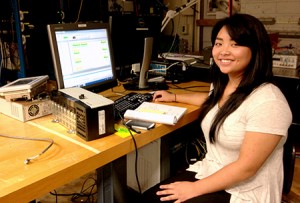 Mickie Hirata was born in Hilo and raised in Waimea on the Big Island. After graduating from Hawaii Preparatory Academy, Mickie currently attends the University of Redlands in Southern California. She will be a sophomore this fall and is pursuing the engineering 3-2 program to receive a B.A. degree in Physics, a minor in Mathematics, and a B.S. degree in Electrical Engineering. Although not completely sure until she gets there, she will possibly want to pursue a master’s degree in a specific subject within physics. Mickie hopes to be involved in the discovery of new things as a career. Besides learning new things, she likes to play video games, watch shows and hang out with friends.
Mickie Hirata was born in Hilo and raised in Waimea on the Big Island. After graduating from Hawaii Preparatory Academy, Mickie currently attends the University of Redlands in Southern California. She will be a sophomore this fall and is pursuing the engineering 3-2 program to receive a B.A. degree in Physics, a minor in Mathematics, and a B.S. degree in Electrical Engineering. Although not completely sure until she gets there, she will possibly want to pursue a master’s degree in a specific subject within physics. Mickie hopes to be involved in the discovery of new things as a career. Besides learning new things, she likes to play video games, watch shows and hang out with friends.
Project Title: Integration of the Next Generation Laser Subsystems at W.M. Keck Observatory
Host Organization: W. M. Keck Observatory
Mentors: Jason Chin and Ed Wetherell
Project Abstract:
The W.M. Keck Observatory plans to upgrade the Laser Guide Star Adaptive Optics (LGSAO) System with a Next Generation Laser (NGL) for the Keck II telescope located on the summit of Mauna Kea in October 2015. Since laser adaptive optics observations are in high demand, downtime during the replacement of the laser system must be minimized. To ensure a seamless transition during the integration phase, Keck engineered and built subsystems that were installed and tested on the telescope prior to the laser installation itself. Proper testing and calibration of these subsystems had to be verified for requirements compliance prior to delivery to the summit. Specifically, the Laser Safety System (LSS) will ensure safety for personnel and equipment; a Thin Film Polarizer (TFP) motor will control the laser beam intensity for alignment and calibration; and thermal coupled temperature sensors will ensure the laser is operating at their operating temperatures. These subsystems were assembled, calibrated, tested and documented at headquarters (HQ). After HQ testing was complete, the subsystems were transferred and integrated at the summit with further testing in the operational environment.